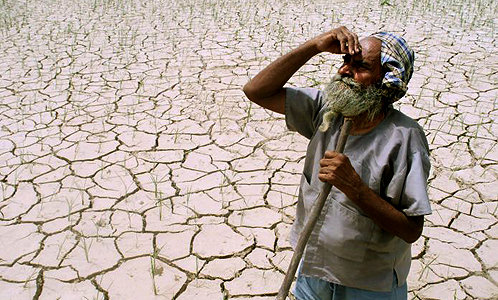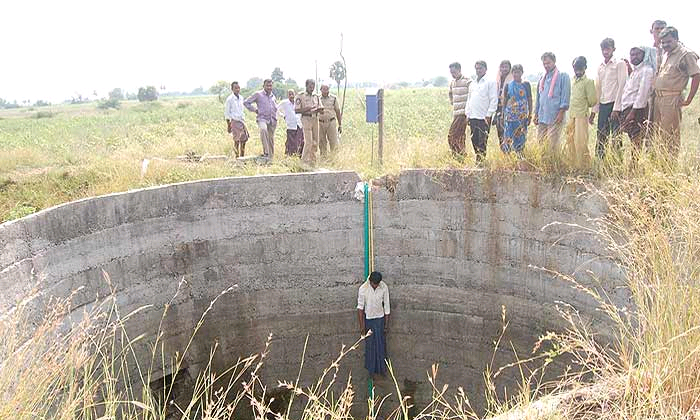The fact that 410 farmers have committed suicide since the beginning of the year in the drought-hit Vidarbha region alone ought to raise questions about the unabashed corporate takeover of agriculture, writes Aritra Bhattacharya.
At 410 deaths in seven months, the average toll runs into almost two deaths per day. Alarming, by any standard— more so when one considers the fact that 410 is the count in merely six districts. How should we describe this near-catastrophic situation? How should we categorize it? Perhaps, it ought to be more dangerous than the country’s ‘biggest internal security threat’?
And yet, it will never be. For what we are talking about here is farmers ending their lives due to crop failure, bad weather, desperation and whatever else (does it really matter?). For the record, 410 is the number of farmers who committed suicide in Maharashtra’s Vidarbha region since the beginning of the year (2012).
There are many reasons why farmer suicides, despite the dangerous proportion it has assumed in recent years, will never be as big news as the ‘Maoist problem’ is; it will never be billed as the ‘country’s biggest internal security threat’ or some such thing.
But the most important reason of them all is the fact that from the left to the right, all the mainstream political forces in the country see eye-to-eye in the matter of the place of agriculture in the Indian economy, give or take a few issues here and there. They all tend to agree that we need more industry to propel the economy, and more and more people need to move out of agriculture to ensure the supply of cheap labour to industry. Only when there are fewer people engaged in agriculture can landholdings be consolidated and brought under capital-intensive mechanized farming that can also contribute handsomely to the GDP.

The desire to shrink the base of the farming population guides all policy imperatives in agriculture. Proof of where our parties stand on this may be gleaned thus: we have Chidambaram stating that he wants 85% of India to reside in the cities; the BJP laying the ground for the India-US Knowledge Initiatives in agriculture, meant to import more technological knowhow into Indian agriculture; and the mainstream Left trying its best to industrialize the states they rule(d). All kinds of political arrangements have held power at the Centre, yet none has tried to overturn the proceedings set in motion during the green revolution.
The manifestation of this policy direction happens in benign, even apparently positive terms: biotech companies approach agriculturists with promises of doubling, or trebling production if the latter use the companies’ seeds, fertilizers, pesticides, weedicides and whatever else. Farmers fall for this narrative, as does the government, justifying it on account of the fact that agricultural production needs to increase to feed the burgeoning population. For rich farmers with huge tracts of land, the ‘plan’ works very well for some time (with devastating consequences in the long run); for the smaller farmers, without the backing of economies of scale, there is almost immediate abyss.
A drought year, like this one, ought to expose the fault lines of this narrative. The fact that 410 farmers have committed suicide since the beginning of the year in the drought-hit Vidarbha region alone ought to raise questions about the unabashed corporate takeover of agriculture. After all, activists on the ground point out the fact that almost all agriculturists who have ended their lives are small and marginal farmers, worst-hit by the takeover.
Yet, what we have are statements from industry-experts and political leaders calling for more research into developing ‘drought-resistant’ varieties of crops. These pleas ignore naturally-occurring drought resistant varieties of local crops and millets, which are fast becoming extinct but for the efforts of some dedicated organizations.
Farmer suicides, therefore, become the basis for pumping the very forces that have led to them in the first place. The spurt in their number is attributed to drought and the vagaries of nature, the deep-seated agrarian crisis they symptomise, is glossed over.

Figures, such as the suicide toll in Vidarbha in seven months, is used by industry lobbyists and biotech companies to seduce people with the promise of drought-resistant, flood-resistant (add more calamities as per choice) crops only to fill their coffers. Farmers take their promise at face value, only to stare at huge input costs, a drain on resources, and possibly, another crop failure prompting more suicide in the next year. Those who don’t end their lives, branch out to other professions where they might be able to earn without loaning their lives every year. And the base of the farming population gradually shrinks.
All this makes for boring reading, in a sense, and even more boring television. So the media too, largely avoids talking about the crisis. There’s no spectacle of severed heads and mutilated bodies, no hostage drama and no interlocutors, like in the ‘Maoist problem’.
Unlike the Maoist problem again, there is no possibility of the army being called in to push people out of agriculture. Farm suicides, after all, can’t be labeled a law and order problem, not even when the number touches 4,000, or thereabouts in Maharashtra, at the end of the year.
Yet, the figure 410 (or 4,000) is not important—it is the underlying agrarian crisis leading to the figure that is deserves attention, and action. Not the self-serving biotechnology-promoting kind, though.
*conditions apply. While we are on this, let us remember that the administration considers a suicide as a farmer suicide only when the victim has land registered in his/ her name. And so, if a farmer’s wife—also a farmer—commits suicide, the figure does not change.


